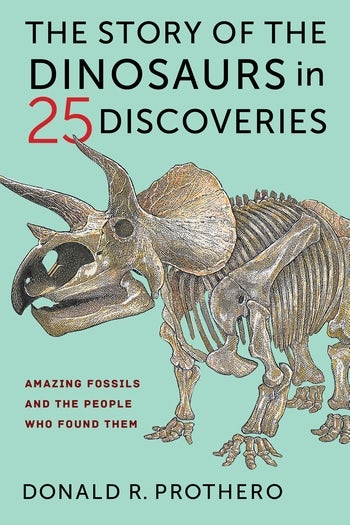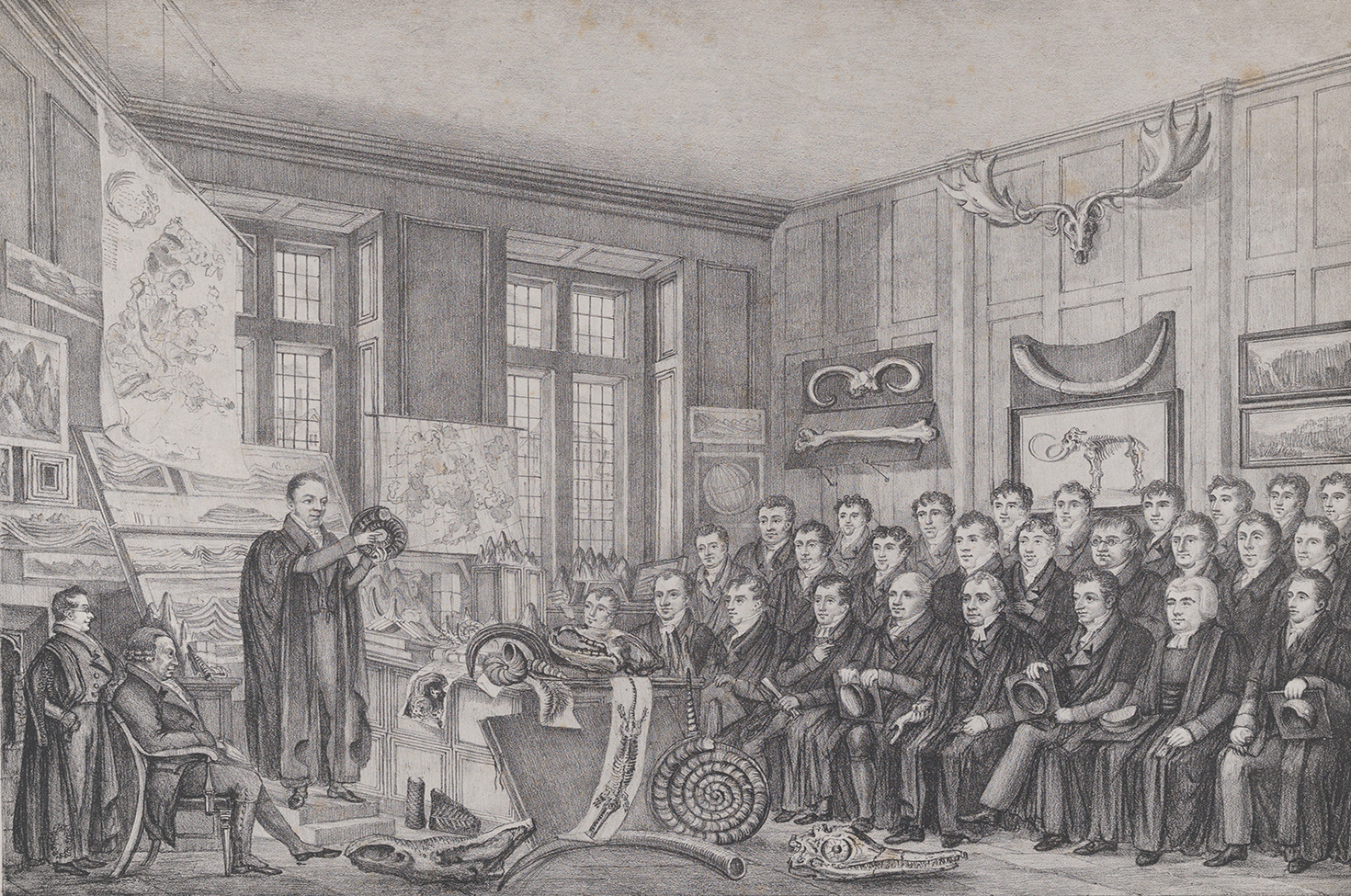
Dr. William Buckland Lecturing in the Geological Lecture Room at Oxford University, c. 1823. The Metropolitan Museum of Art, Purchase, Harry G. Friedman Bequest, 1967.
For centuries, people had picked up huge bones in the ground and puzzled over their origins. In some parts of the world, they were thought to be the remains of legendary dragons, sea monsters, or Cyclopes. On the Greek island of Samos, the numerous large bones were thought to be the remains of Amazon warrior women who had died in battle. (We now know they are the remains of elephants, giraffes, antelopes, cattle, hyenas, and other mammals that were abundantly fossilized there.) The red color of the rocks was thought to be bloodstains (the color actually comes from the rusty iron oxides in the rocks). Large bones of dinosaurs, marine reptiles, and large mammals have been known since prehistoric times, and they have been explained by whatever mythology was prevalent among the peoples who found them.
In Europe, the myths about Earth found in the Bible strongly influenced what people saw in specimens. For example, in 1726 the Swiss scholar Johann Scheuchzer obtained and described a large fossil skeleton of a creature found in Switzerland. His biblical bias was so strong that he thought it was the skeleton of a man who had died in Noah’s flood. He even named it Homo diluvii testis, “man, a witness of the Flood.” Many years later the famous anatomist and paleontologist Georges Cuvier showed it was not human at all but a giant salamander, which is a close relative of the living giant salamanders found in China and Japan. Today it seems laughable that Scheuchzer could mistake a salamander fossil for a human skeleton, but comparative anatomy was in its infancy in 1726, and everyone was preconditioned to see giant humans as described in the Bible.
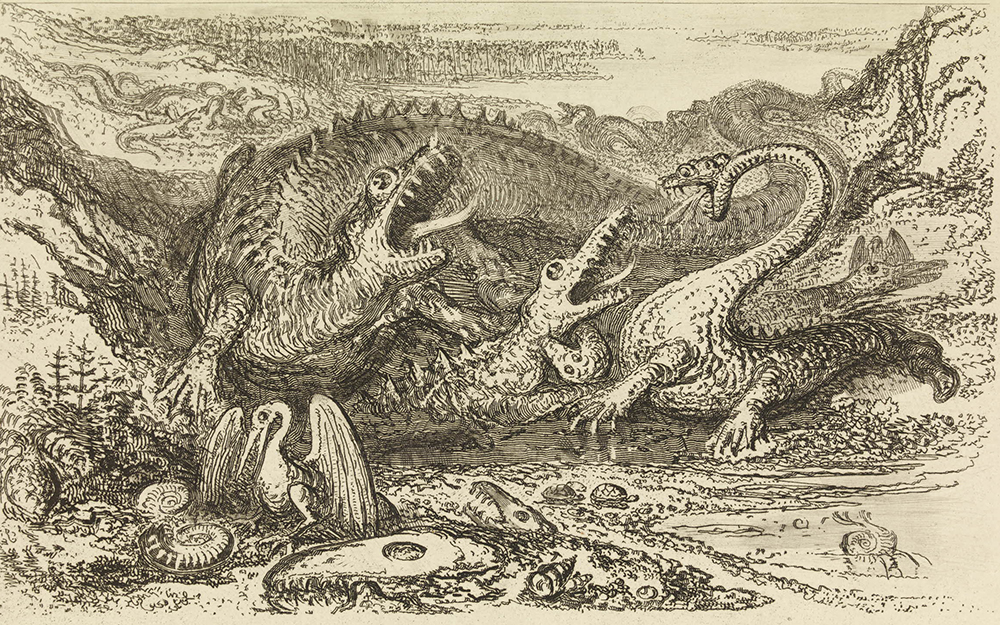
Numerous accounts of giant bones are known in the literature before 1800, but most cannot be tracked down or identified because the fossils have been lost and adequate illustrations, measurements, or locality information are not available to determine what they were talking about. One of the first such fossils that might be identifiable was illustrated in Robert Plot’s 1677 book Natural History of Oxfordshire. Plot was the first professor of chemistry at the University of Oxford, and later he was curator of the Ashmolean Museum of Oxford, established in 1683. He was interested in all areas of natural history known at the time. His book described the living animals and plants of the Oxfordshire region as well as some of the rock and fossils. Among these was a strange piece of fossil bone that Plot correctly guessed was the end of a thighbone (femur) of a very large creature. This description was unusual for Plot because he did not believe that most fossils were the petrified remains of animals. Instead he imagined that they were formed by crystallization inside rocks.
The specimen had been found in quarries north of Oxford, from a formation we know now is the Middle Jurassic Taynton Limestone. It was much too large to match any animal currently found in England, so Plot guessed that it came from the skeleton of a war elephant used when the Romans conquered Britannia. Later he thought that it might be from a giant human, as mentioned in the Bible. The fossil has since been lost, but it is the first adequately illustrated dinosaur fossil known and is almost certainly from the Megalosaurus.
This first known dinosaur was almost given a truly inappropriate name. In 1763 Richard Brookes republished Plot’s illustration and called the fossil Scrotum humanum in a figure caption. Indeed, to someone who doesn’t know anatomy well and is conditioned to see every large fossil as a relict of biblical giants, it does look a bit like a pair of huge human scrota and the base of a penis. In addition, the form of Brookes’ name suggests the genus and species binomial naming system devised by Carl Linnaeus in 1758 and earlier not only for animals and plants but also for natural curiosities found in rocks. In 1970 the eccentric British paleontologist Lambert Beverly Halstead (famous for trying to act out dinosaurs mating when giving presentations at scientific meetings) published an article suggesting that the first named dinosaur was properly called Scrotum humanum. Later paleontologists asked the International Commission on Zoological Nomenclature (the body that makes the rules about scientific names) to formally suppress the name Scrotum humanum. The commission ruled that this was unnecessary because the name was only published in a caption, without adequate description or diagnosis, the only specimen was lost, and it was not certain that it was the same as Megalosaurus.
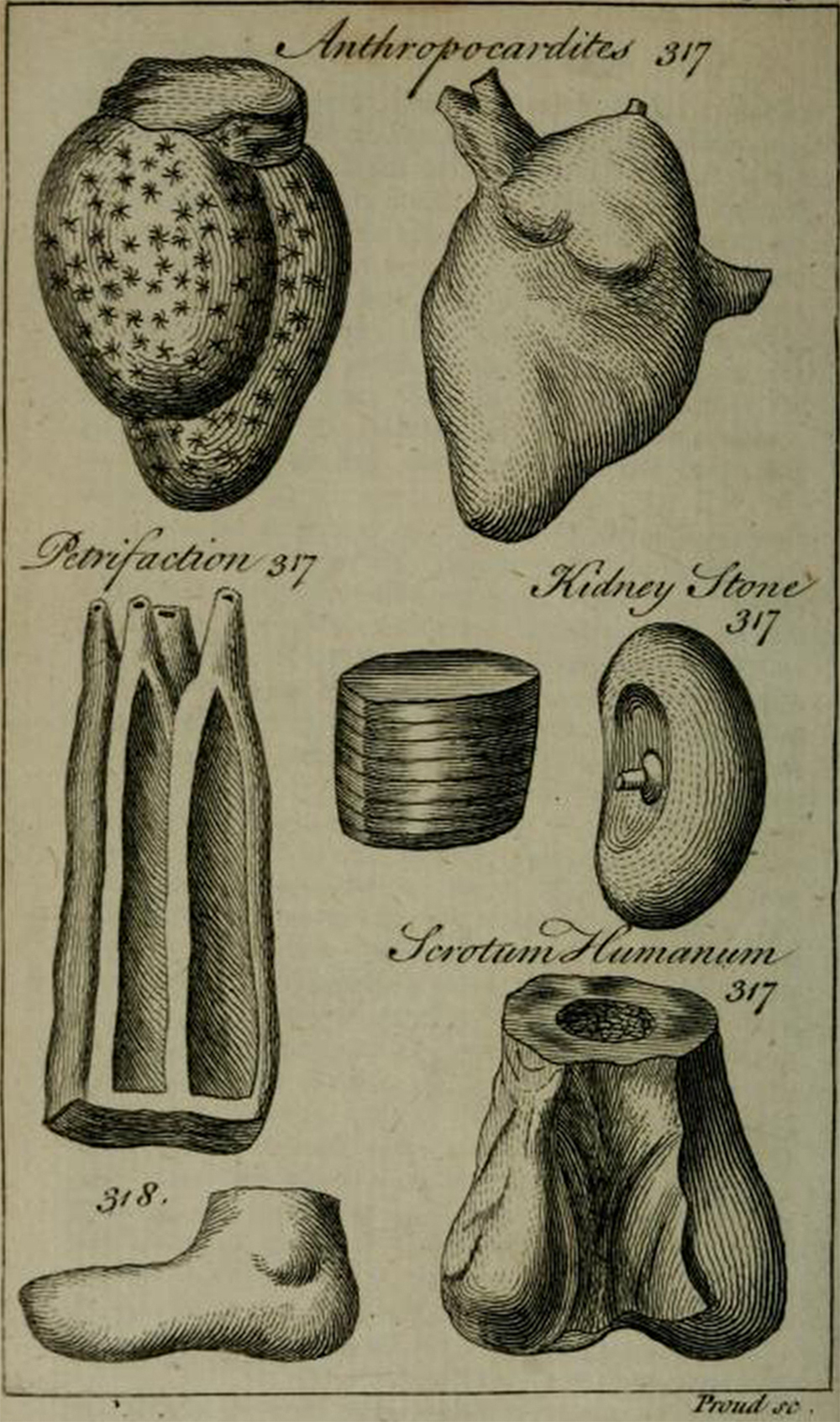
Even though the original fossil was lost, specimens continued to be found in Stonesfield that ended up in the Oxford collections. By 1815 there were quite a few bones, and they caught the attention of the legendary naturalist Sir William Buckland.
Buckland was one of the most amazing and colorful figures in the history of science. Born in 1784 in Axminster in Devon in southwestern England, he accompanied his father (the local church rector) on fossil-collecting walks on the coastline at Lyme Regis (later famous for the marine reptiles found by Mary Anning) and developed an early interest in natural history. After attending several schools, he ended up studying mineralogy and chemistry at Corpus Christi College in Oxford, where he would spend most of the rest of his life. By 1813 he had succeeded his mentor John Kidd as a reader in mineralogy at Oxford, and he soon became famous for his popular and engaging style of lecturing. Buckland was known for his dramatic delivery and gestures during lectures, sometimes acting out the behavior of the animals he was describing. According to one story from The Life and Correspondence of William Buckland, D.D., F.R.S. (1894),
He paced like a Franciscan Preacher up and down behind a long show-case, up two steps, in a room in the old Clarendon. He had in his hand a huge hyena’s skull. He suddenly dashed down the steps—rushed, skull in hand, at the first undergraduate on the front bench—and shouted, “What rules the world?” The youth, terrified, threw himself against the next back seat, and answered not a word. He rushed then on me, pointing the hyena full in my face—“What rules the world ?” “Haven’t an idea,” I said. “The stomach, sir,” he cried (again mounting his rostrum), “rules the world. The great ones eat the less, and the less the lesser still.”
He even gave lectures on horseback. He wore his heavy academic robes at every lecture and scrambled around outcrops on a field excursion in formal clothes.
His eccentricities extended to his household, which was loaded with specimens of fossils, minerals, and animals he had collected. He and his wife, Mary Morland (a talented naturalist and illustrator in her own right), would debate which species of fly was buzzing around the table, a common phenomenon in the early 1800s when both men and women were obsessed with natural history. The entire family (nine children, five of whom survived into adulthood) was recruited to collect natural history specimens.
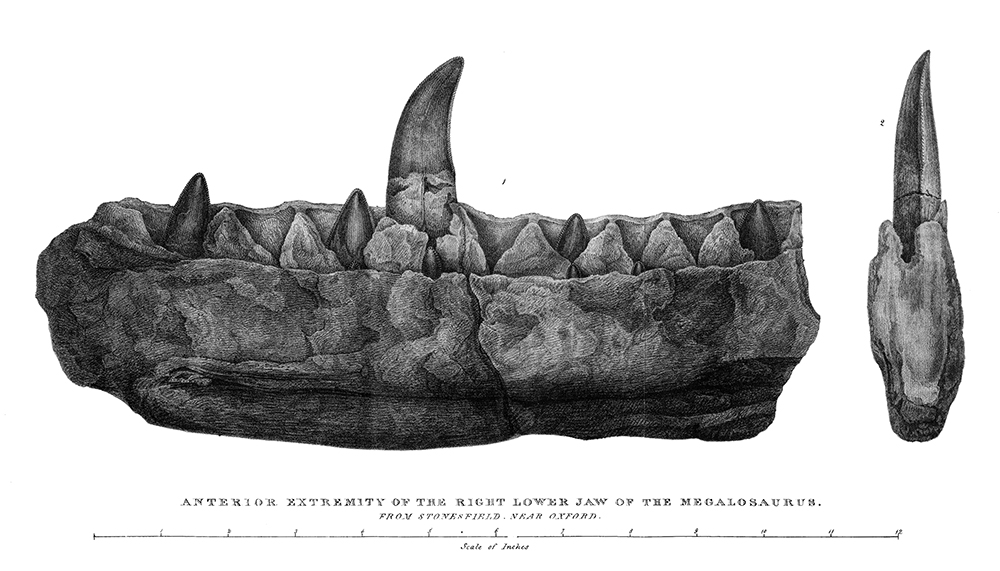
Buckland was so enthusiastic about experiencing animals directly that he claimed he had eaten his way through the animal kingdom. The Bucklands tried to make a meal from almost every animal they could obtain, a practice known as zoophagy. Mole and bluebottle fly were apparently the most disgusting, but his guests also record him eating panther, crocodile, and mouse. Another account has them eating (and offering to their guests) crisp mice in golden batter, panther chops, rhino pie, trunk of elephant, crocodile for breakfast, sliced porpoise head, horse's tongue, and kangaroo ham. According to Augustus Hare, in his autobiography The Story of My Life (1900), “talk of strange relics led to mention of the heart of a French king [possibly Louis XIV] preserved at Nuneham in a silver casket. Dr. Buckland, whilst looking at it, exclaimed, ‘I have eaten many strange things, but have never eaten the heart of a king before,’ and, before anyone could hinder him, he had gobbled it up, and the precious relic was lost forever.” Buckland had been looking at the huge bones in the Oxford collection from the Stonesfield Slate Quarry for some time. After the end of the Napoleonic Wars, in 1818, Cuvier came to Oxford to see these remarkable huge fossils. Cuvier looked at them closely (especially the jaw with its reptilian teeth, many of which were just erupting) and decided they were the remains of a huge lizard. Buckland and his friend William Conybeare continued to call it the “Huge Lizard,” which Conybeare rendered into Greek as Megalosaurus, and informally used that name in 1822 in an unpublished article intended for one of Cuvier’s volumes. James Parkinson published this unofficial name that same year, but luckily this publication had no standing in the codes of zoology (there was no description or any other indications with the name). Finally, on February 20, 1824, Buckland presented a paper on Megalosaurus at the annual meeting of the Geological Society of London. At the same meeting, Conybeare described the first plesiosaurus, found at Lyme Regis by Mary Anning. A few months later Buckland’s formal descriptions (with illustrations of the bones done by his wife) appeared in the Transactions of the Geological Society of London, giving Megalosaurus official status. Buckland did not give it a species name, however, and in 1826 Ferdinand von Ritgen named it Megalosaurus conybeari. This name never caught on, and in 1827 Gideon Mantell named it Megalosaurus bucklandii, in honor of the man who described it for science.
Buckland tried to reconstruct what the animal looked like, but he had very little to go on: just a jaw and part of a skull, some hind limb bones, the hip bones, and part of the spinal column. Because everyone thought it was a huge lizard, nearly all the reconstructions showed it walking on four huge stumpy limbs. Analyzing the shape of its hind limbs, Buckland realized that they had been held in an upright vertical posture, so Megalosaurus was not reconstructed as a giant sprawling lizard but as something that had a reptilian head and an elephantine body. In his original 1824 description, Buckland followed Cuvier in suggesting that it was forty feet long and was as heavy as a seven-foot-tall elephant. In the printed version of his lecture, Buckland upped the length estimate to sixty to seventy feet. There was really no way to tell because none of the tailbones were found.
For many people, a huge reptile with wicked-looking teeth conflicted with their literal interpretation of the Bible, with the lion lying down by the lamb, and all the animals living in a “peaceable kingdom” before Adam’s fall. Buckland was a good enough naturalist to reject the ridiculous idea that Megalosaurus was a vegetarian with those sharp, slashing teeth (an idea revived by modern-day creationists, who claim that Tyrannosaurus rex used its sharp teeth to open coconuts). Instead, Buckland proposed that God had assigned Megalosaurus a benign role: getting rid of old and sick animals “to diminish the aggregate amount of animal suffering” (in his words).
By 1842 Richard Owen had united Megalosaurus with two other discoveries (Iguanodon and Hylaeosaurus) to create the taxon Dinosauria, and the public began to appreciate the diversity of huge extinct monsters. Owen recruited the sculptor Benjamin Waterhouse Hawkins to make life-size models of these amazing creatures for the Great Exhibition of 1851 as part of the incredible Crystal Palace exhibits. These are on display in Crystal Palace Park in Sydenham today where anyone can view them. Hawkins reconstructed Megalosaurus according to Owen’s directions as a huge lumbering elephantine predator, and in some illustrations they were shown preying on the larger herbivore Iguanodon. Even though the models were grossly inaccurate by modern standards, they were consistent with the then current idea that dinosaurs resembled huge lizards on four limbs. Owen viewed them as “super-reptiles,” and the much smaller modern reptiles were the degenerate successors to them. Unfortunately, at that time there were not enough fossils to prove otherwise. These models were among the first to raise the public consciousness of the existence of dinosaurs, and they stirred the first wave of “dinomania.”
Excerpted from The Story of the Dinosaurs in 25 Discoveries: Amazing Fossils and the People Who Found Them by Donald R. Prothero Copyright © 2019 Donald R. Prothero. Used by arrangement with the Publisher. All rights reserved.
